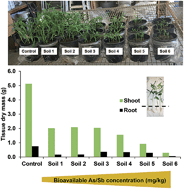As and Sb are more labile and toxic to water spinach (Ipomoea aquatica) in recently contaminated soils than historically co-contaminated soils†
Abstract
Elevated concentrations of As and Sb impact environmental quality and human health. In this study total and bioavailable As and Sb were measured from recently and historically contaminated soils and the phytotoxicity of these soils was evaluated with Ipomoea aquatica (35-d exposure from germination) using biomass, length of plant tissues and photosynthetic efficiency. As and Sb were both present within the soil (co-contaminated). The bioavailable As and Sb in soils were determined by a Sequential Extraction Procedure (SEP) and compared to total soil concentrations and bioaccumulation in the edible parts of I. aquatica. For both As and Sb, bioavailable concentrations increased proportionally with the total soil concentrations and greater bioavailability in recently contaminated soil was observed. Tissue dry mass and length drastically reduced with increasing total and SEP-bioavailable As and Sb soil concentrations. The total soil concentration was a less sensitive measure of the phytotoxicity of As and Sb than the bioavailable fraction. Shoot length was inhibited by 50% (EC50) at bioavailable As concentrations of 80–96 mg kg−1 in both recently and historically contaminated soils; however, bioavailable Sb EC50 for shoot length was achieved at lower bioavailable concentrations, 96 (42–219) and 12 (7–19) mg kg−1 in recently contaminated soils and historically contaminated soils, respectively. Shoot biomass was inhibited by 50% (EC50) at bioavailable As concentrations of 11 (4–30) and 49 (37–65) mg kg−1 in recently and historically contaminated soils, respectively whereas this occurred at much lower bioavailable Sb concentrations, 2–5 mg kg−1 in both recently and historically contaminated soils. Aging is important in contaminated soils, it decreases the lability of As and Sb and hence their bioavailability to agricultural plants, thus posing a lower risk of exposure of these metalloids to humans through agricultural plants grown in contaminated soils.



 Please wait while we load your content...
Please wait while we load your content...